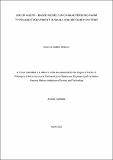| dc.contributor.author | Nyambo, Devotha | |
| dc.date.accessioned | 2020-09-14T07:27:36Z | |
| dc.date.available | 2020-09-14T07:27:36Z | |
| dc.date.issued | 2020-04 | |
| dc.identifier.uri | http://doi.org/10.58694/20.500.12479/895 | |
| dc.description | A Thesis Submitted in Fulfilment of the Requirements for the Degree of Doctor of
philosophy in Information and Communication Science and Engineering of the Nelson
Mandela African Institution of Science and Technology | en_US |
| dc.description.abstract | The ever-increasing demand for milk and dairy products has attracted research interventions
on how milk yield can be increased for the context of smallholder farmers. While bearing
significant contribution on milk production and fulfilment of the market demand, the
smallholder dairy farmers are faced with challenges that hinder productivity. Among the
challenges is the inadequate characterization of the dairy production systems and lack of
knowledge on factors attributing to their growth. This has resulted in aggregation of the
smallholder dairy farmers and lack of interventions tailored to suit particular farm types. By
using Tanzania and Ethiopia as case studies, this research identified the main determinants for
evolvement of smallholder dairy farmers. Evolvement in this research refers to, gradual
increase in milk yield. The factors that determine evolvement for individual farm typologies
were identified by using cluster and frequent pattern analysis. The differential influence of the
identified determinants towards increase in milk yield was studied by using Agent-based
modelling and simulation where each factor was observed.
Six farm types were identified for Tanzania and four for Ethiopia. The characteristics of the
farm types were enriched by frequent pattern analysis with confidence level 60% - 97%. Agentbased
modelling
revealed
that,
income
and
farm-based
determinants
influenced
an
increase
of
up
to
7.58
litres
above
the
average
(13.62
±
4.47)
for
Ethiopia.
For
Tanzania,
farm
and
farmerbased
determinants
influenced
an
increase
of
up
to
7.72
litres
of
milk
above
the
average
(12.7
±
4.89).
The
identified
determinants
could
predict
up to
96%
and
93%
of
the
variances
in
milk
yield
for
Tanzania
and
Ethiopia,
respectively.
There was an increase in milk yield based on
the identified evolvement determinants; from baseline data average milk yield of 12.7 ± 4.89
and 13.62 ± 4.47 to simulated milk yield average of 17.57 ± 0.72 and 20.34 ± 1.16 for Tanzania
and Ethiopia, respectively. Dairy development agencies should consider the disaggregation of
dairy farmers and prioritization of the determinants identified in this research for evolvement
of dairy farms. In future, it is important to develop a web or mobile application that can inform
smallholder dairy farmers about the identified evolvement determinants to aid on-farm decision
making. | en_US |
| dc.language.iso | en | en_US |
| dc.publisher | NM-AIST | en_US |
| dc.rights | Attribution-NonCommercial-ShareAlike 4.0 International | * |
| dc.rights.uri | http://creativecommons.org/licenses/by-nc-sa/4.0/ | * |
| dc.subject | Research Subject Categories::NATURAL SCIENCES | en_US |
| dc.title | Use of agent – based models in characterizing farm types and evolvement in smallholder dairy systems | en_US |
| dc.type | Thesis | en_US |


